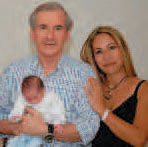Lifesaving Heroics

Prof. Israel Meizner with Limor Agamy and her son
Professor Israel Meizner, head of the Ultrasound Unit at Rabin Medical Center's Hospital for Women, has performed thousands of ultrasounds and invasive procedures on pregnant women throughout his long career, but nothing like the extraordinary ultrasound of Limor Agamy. In her twentieth week of pregnancy, a huge cyst was observed in the right fetal lung and doctors attempted to alleviate this problem using pleuro-amniotic shunting to drain the fluids. During this procedure, Prof. Meizner discovered that the fetal pleural cavity had filled with blood, the heart was compressed to the side, and there was only a faint heartbeat. It was obvious that the fetus was dying.
Without a second thought, Prof. Meizner performed a lifesaving procedure by placing a needle straight into the fetal thorax and pumping out the blood that had accumulated. As he carried out this very delicate and dangerous procedure, the fetus's lungs expanded and a normal heartbeat was restored, saving the unborn baby's life. In her thirty-eighth week of pregnancy, Limor gave birth to a beautiful healthy son. Her joy was indescribable.
Related Articles
Early Menopause - Serious Issue for Breast Cancer Patients
In Israel, this year alone, about 1,000 women under the age of 50 will discover they have breast cancer. If this is not devastating enough, many of these young women, still of childbearing age, will go into early menopause as a result of life saving chemotherapy treatments.
The Natalie Katzin Gerber Fellowship
A ceremony with Dr. Eyran Halpern, CEO of Rabin Medical Center, was recently held in celebration of the money raised by Batya Rotter and friends, during the recent American Friends of Rabin Medical Center's NYC Schlep: Jewish Breast Cancer 5K Run/Walk held at Battery Park in Manhattan.
Less Anxierty Improves In Vitro Fertilization
For many women who have difficulty getting pregnant, the in vitro fertilization (IVF) process can be extremely stressful and all consuming.